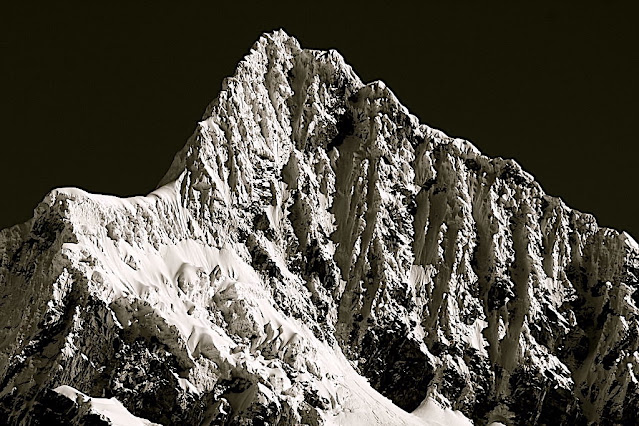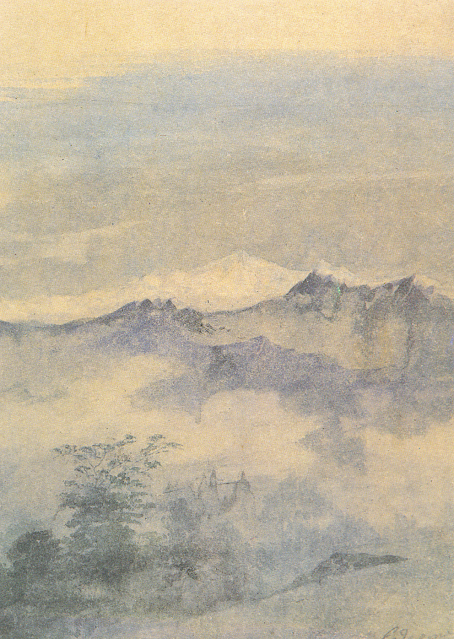Mont Everest / Chomolunga (8,848 m - 29,029ft)
Chine-Népal
In Himalayas, c. 1920, Huile sur toile, 18 x 22 in. Private collection,
Courtesy James Main Fine Arts, Santa Barbara
La montagne
L'Everest / Chomolungma / Sagarmāthā (8,848 m - 29,029ft) st une montagne située dans la chaîne de l'Himalaya, à la frontière entre le Népal (province de Koshi) et la Chine (région autonome du Tibet). Il est aperçu par des Européens pour la première fois en 1847 puis, après quelques années d'observations et de calculs, il est identifié comme le plus haut sommet du monde. Son altitude est établie à 8 849 mètres. Cette caractéristique lui vaut d'être baptisé de son nom actuel par les Occidentaux en 1865 en l'honneur de George Everest, arpenteur général des Indes orientales de 1830 à 1843, et, dès les années 1920, de susciter l'intérêt des alpinistes qui se lancent à l'assaut de ses faces. Plusieurs expéditions, en particulier britanniques, se succèdent depuis le versant nord au Tibet. Toutefois, les conditions météorologiques extrêmes font leurs premières victimes, parmi lesquelles George Mallory et Andrew Irvine, en 1924, dont on ne saura probablement jamais avec certitude s'ils ont atteint le sommet. En 1950, le Népal autorise l'accès à la montagne depuis le sud offrant des possibilités d'ascension par l'arête Sud-Est, moins périlleuse. Finalement, trois ans plus tard, Edmund Hillary et Tensing Norgay deviennent les premiers hommes à atteindre le sommet de l'Everest. Dès lors, les exploits en tous genres s'enchaînent, alimentant les fantasmes populaires ; mais, en 1996, une série d'accidents mortels vient rappeler les dangers liés à la montagne, portant de nos jours à plus de 200 le nombre de victimes. Pourtant, le tourisme de masse se généralise, fragilisant ce milieu naturel malgré les créations du parc national de Sagarmatha en 1976 et de la réserve naturelle du Qomolangma en 1988. Ainsi, plus de 14 000 alpinistes ont tenté l'ascension depuis 1922 et plus de 4 000 l'ont réussie, bien aidés, pour la majorité d'entre eux, par les porteurs sherpas et l'utilisation de bouteilles d'oxygène.
Le peintre
Colin Campbell Cooper, Jr. est un peintre neo-impressioniste américain né à Philadelphie, en Pennsylvanie dans une famille d’origine anglo-irlandaise. Sa mère, Emily Williams Cooper, dont les ancêtres ont émigré aux États-Unis depuis Weymouth dans le Dorset en Angleterre, était un peintre amateur d’aquarelle. Son père, le Dr Colin Campbell Cooper - dont le grand-père est venu de Derry, en Irlande- était un chirurgien et passionné par les arts. Étant jeune, Colin fut à son tour inspiré par l'art en particulier après sa participation à l’Exposition universelle de 1876. Ses deux parents, favorables à ses ambitions, l'encourage à devenir un artiste. Il est célèbre pour ses peintures architecturales, en particulier de gratte-ciel à New York, Philadelphie ou Chicago. C’est aussi, un voyageur avide, connu pour ses peintures de monuments européens et asiatiques. Il peint aussi de nombreux paysages naturels, des portraits, des fleurs. Il était aussi enseignant et écrivain.
_________________________________________
2023 - Wandering Vertexes ....
Errant au-dessus des Sommets Silencieux...
Un blog de Francis Rousseau
%20Himalayas,%20c.%201920%20Oil%20on%20board,%2018%20x%2022%20inches,%20%20%20Private%20collection,%20Santa%20Barbara-%20courtesy%20JAmes%20MAin%20Faineart%20s.png)

-%20Nuptse%20%20Himalaya%202011%20%20acrylic%20on%20paper-%20John%20Mitchell.jpg)














